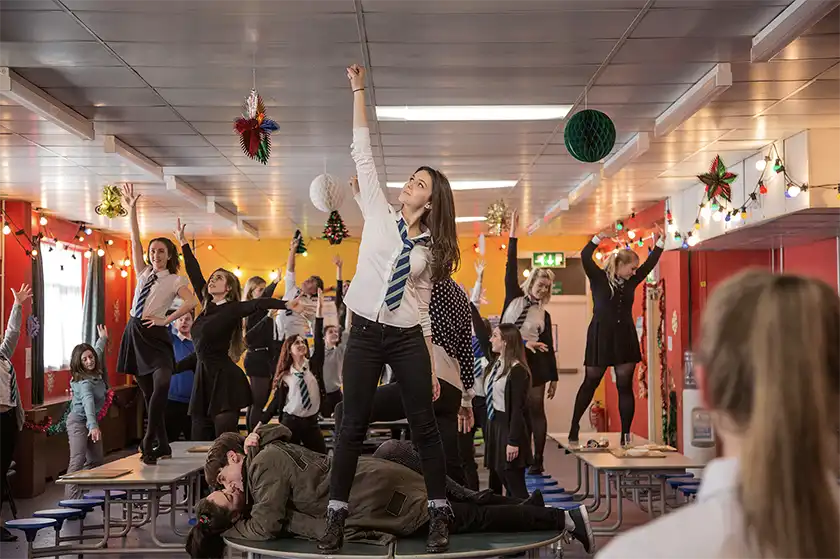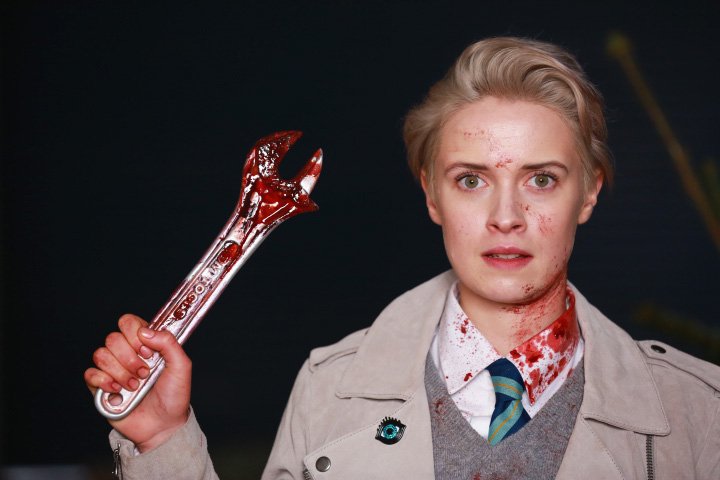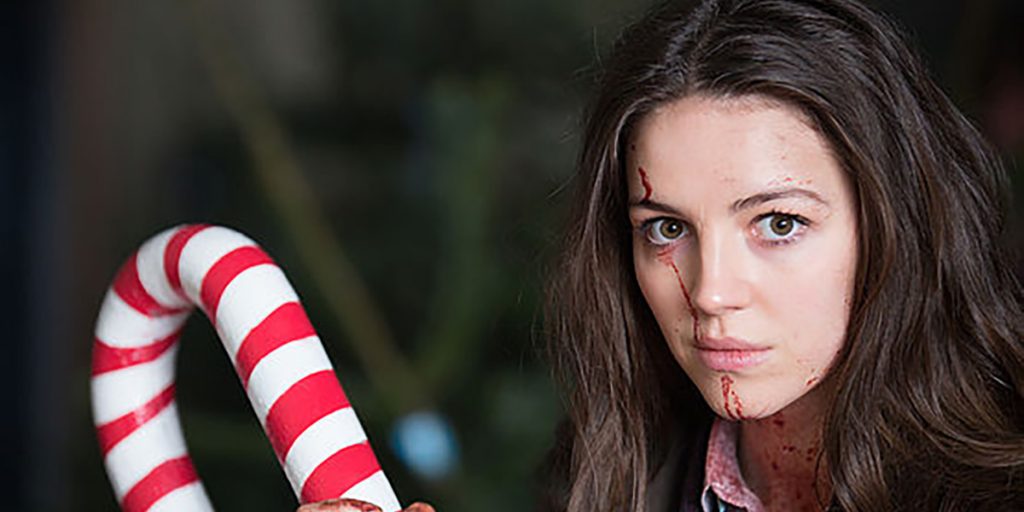John McPhail tackles the genre hybrid trend with Anna and the Apocalypse, a zombie horror film which is also a musical comedy with a Christmasy vibe.
Genre hybrid films have always been a thing. From Jim Sharman’s The Rocky Horror Picture Show (1975) to John Landis’ An American Werewolf in London (1981); from Ridley Scott’s Blade Runner (1982) to David Fincher’s Se7en (1995); from Michel Gondry’s Eternal Sunshine of the Spotless Mind (2004) to Quentin Tarantino‘s Django Unchained (2012), directors have been combining genres in cinema for years. And so, we were given romance dramas that were also tragedies, satirical horror films, sci-fi dystopian thrillers with elements of the noir genre and even westerns with aliens.
As the years went by, our favourite directors kept experimenting and released oh so many seriously weird mashups (Pride and Prejudice and Zombies, Cowboys and Aliens, Eden Lake… The list goes on), but also the occasional masterpiece. Sci-fi western Back to the Future 3, comedy ghost story Ghostbusters, and Tim Burton’s Halloween/Christmas musical The Nightmare Before Christmas are among the most imaginative examples of hybrid genre films that have effectively become part of our pop culture.
These kinds of genre hybrid movies are also becoming more popular by the day. This year’s Venice Film Festival line-up confirms the latest trend, as two of the films that will be presented as part of the official competition are “mashups”: Jacques Audiard’s The Sisters Brothers is a dark comedy with western vibes, while the Coen Brothers’ The Ballad of Buster Scruggs is made of six episodes, each belonging to a different genre.
Director John McPhail’s (Where Do We Go From Here?) first attempt at tackling the genre hybrid is Anna and the Apocalypse, a teenage comedy-horror-musical-Christmas movie that takes place during the holidays, in a small town called Little Haven, and in the middle of a zombie apocalypse. Though the film begins with classic coming-of-age material, as the main dilemma appears to be Anna’s (Ella Hunt, of The More You Ignore Me) decision to disregard her father’s wishes and travel instead of going straight to uni after school, it then takes a different turn as the zombies arrive and madness ensues.
But the apocalypse doesn’t just put Anna’s dreams on hold: the unexpected arrival of zombies brings an equal mix of gory fight scenes and hilarious sequences that join the ever-present high school drama, and let’s not forget the Christmas references and, most of all, the music. Because Anna and the Apocalypse is also a musical in the best sense of the word: there’s singing, there’s dancing, there are perfectly timed ensemble numbers with colorful props, captivating choreographies and extremely catchy songs with quality lyrics that you simply won’t be able to get out of your head.

Though the presence of all these different genres is Anna and the Apocalypse‘ strength, as it makes it not only entertaining and fun but also a unique, it’s also unfortunately its weakness. Director John McPhail and screenwriters Alan McDonald (One Night in Sutherland Hill) and Ryan McHenry’s (Zombie Musical) attempt to make a “hybrid” that belongs to so many genres results in a film that is certainly compelling and enjoyable, as its structure and narrative development make a lot of sense, but that also lacks an identity of its own.
The film’s lack of a distinct identity is most noticeable in certain scenes of the film that are bound to remind you of certain entries in the genre. For example, when Anna cheerfully leaves her house and goes to school completely unaware that she is surrounded by zombies, we can’t help but think of the almost identical (but better) sequence in Edgar Wright‘s Shaun of the Dead, where its titular character fails to notice that he’s in the middle of the zombie apocalypse while going to the convenience store. Though Anna’s weapon of choice is candy cane and Shaun’s is a cricket bat, the parallels are certainly there, and this resemblance is made even more obvious by the fact that Shaun of the Dead’s infamous sequence makes sense for characterisation and narrative purposes, highlighting the kind of British attitude that the film’s protagonist embodies.
As the film goes on and more genres are added to the mix, so are the references to other scenes we’ve already seen somewhere else. From the obvious High School Musical to Mean Girls and even Pirates of the Caribbean, the “homages” go on, so much so that we start to question the very definition of a homage. After a while, it becomes a struggle to find any elements in Anna and the Apocalypse that we haven’t seen somewhere else, and that is a real shame, as McPhail’s horror-comedy(-musical-Christmas film) didn’t need to resort to homages to be original and unique.
Anna and the Apocalypse is at its best when it lets its talented cast shine, giving us scenes that are both absurd and believable, thanks to their incredible commitment to the film. Not only that, but the film’s gorgeous cinematography and well choreographed scenes are instantly memorable, putting us in a holiday mood while also preserving the uniqueness of a film that also has very real zombies, as well as very resourceful teenagers, in it.

Anna and the Apocalypse was a very ambitious project. It might not have turned out to be the most original genre hybrid movie, but it still remains a fun film to watch. It’s not a perfect film as a whole, but it’s an excellent musical, and what it lacks in originality it makes up for in acting and style.
Ella Hunt is exceptional as Anna, and so are her “zombie-fighting” co-stars, such as Malcolm Cumming (John), whose undeniable charisma demands our attention in every single scene he’s in, Ben Wiggins (Nick), who makes us change our mind a few times about how much of a “bully” his character really is, Marli Siu (Lisa), Christopher Leveaux (Chris) and Ella Jarvis (Katie), who provide most of the comic relief in the movie, and Sarah Swire (Steph), who not only absolutely owns the difficult role she is given to play, but who also choreographed all the dance sequences in the film.
Though, in some ways, Anna and the Apocalypse is a missed opportunity, it is also a film that is as well-acted and choreographed as it is narratively imaginative and remarkable on a technical level. Which not only makes it worth a watch, but also marks John McPhail as a director to keep an eye on.
Anna and the Apocalypse premiered at the 2018 Edinburgh Film Festival and is now available to watch on digital and on demand.

